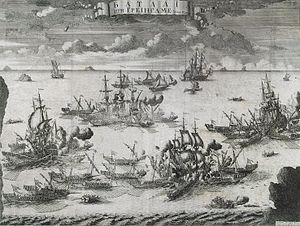Sea battle at Grönham
| date | July 27 jul. / 7th August 1720 greg. |
|---|---|
| place | Grengam , Åland |
| output | russian victory |
| Parties to the conflict | |
|---|---|
| Commander | |
| Troop strength | |
| 1 ship of the line 4 frigates 9 smaller ships 1000 men |
52 galleys 15 sailing ships 11,000 men |
| losses | |
|
103 dead and 407 prisoners, 4 frigates |
82 dead, 236 wounded and 43 galleys |
1st phase: Swedish dominance (1700–1709)
Riga I • Jungfernhof • Varja • Pühhajoggi • Narva • Pechora • Düna • Rauge • Erastfer • Hummelshof • Embach • Tartu • Narva II • Wesenberg I • Wesenberg II
Arkhangelsk • Lake Ladoga • Nöteborg • Nyenschanz • Neva • Systerbäck • Petersburg • Vyborg I • Porvoo • Neva II • Koporje II • Kolkanpää
Vilnius • Salads • Jacobstadt • Walled Courtyard • Mitau • Grodno I • Olkieniki • Nyaswisch • Klezk • Ljachavichy
Klissow • Pułtusk • Thorn • Lemberg • Warsaw • Posen • Punitz • Tillendorf • Rakowitz • Praga • Fraustadt • Kalisch
Grodno II • Golovchin • Moljatichi • Rajowka • Lesnaja • Desna • Baturyn • Koniecpol • Weprik • Opischnja • Krasnokutsk • Sokolki • Poltava I • Poltava II
2nd phase: Sweden on the defensive (1710–1721)
Riga II • Vyborg II • Pernau • Kexholm • Reval • Hogland • Pälkäne • Storkyro • Nyslott • Hanko
Helsingborg • Køge Bay • Gulf of Bothnia • Frederikshald I • Dynekilen Fjord • Gothenburg I • Strömstad • Trondheim • Frederikshald II • Marstrand • Ösel • Gothenburg II • Södra Stäket • Grönham • Sundsvall
Elbing • Wismar I • Lübow • Stralsund I • Greifswalder Bodden I • Stade • Rügen • Gadebusch • Altona • Tönning II • Stettin • Fehmarn • Wismar II • Stralsund II • Jasmund • Peenemünde • Greifswalder Bodden II • Stresow
The sea battle at Grönham (or sea battle at Grengam ) from July 27th jul. / 7th August 1720 greg. was the last great naval battle in the Great Northern War . It took place near the Aland Islands , in Ledsundstrasse between the island settlements of Föglö and Lemland . The Russian galley fleet under the command of Mikhail Mikhailovich Golitsyn defeated a Swedish sailing flotilla under the command of Carl Georg Siöblad .
prehistory
Since the naval battle of Hanko in 1714, Russia had naval rule in the northern part of the Baltic Sea. In the years that followed, Russian galley fleets repeatedly carried out attacks against the Swedish coast. The Swedes' large ships of the line could not operate against the Russian galleys close to the coast, so an effective defense of these sections was not possible.
At the end of July 1720, Peter I ordered the Russian fleet, consisting of 52 galleys and 15 sailing ships with 52 cannons and 11,000 men, to occupy the Aland Islands in the Gulf of Bothnia and to drive the Swedes from the archipelago. The fleet was led by General Golitsyn. The Swedish fleet, under the command of Vice Admiral Carl Georg Siöblad, had a ship of the line with 52 cannons, 4 frigates and 9 smaller ships with a total of 156 cannons and over 1000 soldiers. Siöblad made an attempt to attack the Russians on the approach.
course
Due to the superior Swedish artillery, the Russian general Golitsyn withdrew to the rocky archipelagos of the Aland Islands. The Swedes pursued the Russian ships, but Golitsyn managed to occupy an advantageous position on a narrow strait and made his ships form a semicircle. The Swedish ship of the line and four frigates following the ships entered the sea route. Two of the frigates ran aground on rocks. The Swedes now realized their disadvantageous position and began to withdraw. The Russian galleys, which had a clear advantage due to their better maneuverability, pursued the remaining two frigates and captured them after heavy fighting. The only Swedish ship that managed to escape was Vice Admiral Siöblad's flagship.
consequences
The Swedish 34-cannon frigate Stor Phoenix , the 30-cannon Vainqueur , the 22-cannon Kiskin and the 18-cannon frigate Danska Orn were conquered by the Russians. The Swedes lost 103 dead and 407 prisoners. The Russian fleet had suffered losses of 82 dead and 236 wounded.
The victory at Grönham secured the Russian conquests and was important in order to be able to carry out further operations against Swedish ships in the region. In 1721, the last year of the war, Russian galleys raided Swedish cities along the Swedish coast.
literature
- Alastair Wilson, Joseph F. Callo: Who's who in Naval History: From 1550 to the Present. Routledge, 2004, ISBN 0-415-30828-3 .
- William Richard Morfill: A History of Russia: From the Birth of Peter the Great to Nicholas II. James Pott Publisher, London 1902.
- George Bruce: Harbottle's Dictionary of Battles. Van Nostrand Reinhold, 1981, ISBN 0-442-22336-6 .
- Gunnar Unger: Illustrerad svensk sjökrigshistoria, omfattande tiden 1680–1814. Albert Bonniers Förlag, Stockholm 1923.
- Magnus Ullman: Rysshärjningarna på Ostkusten sommaren 1719. Stockholm 2006, ISBN 91-631-7602-5 .


